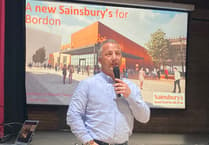IT is no secret that most of the legal planning process is, for normal people at least, not terribly exciting.
But, after years of technical jargon and government speak, regeneration stakeholders have finally arrived at the fun part of development - naming their creations.
This week the task fell to Whitehill Town Council to suggest names for the southern section of the town’s new relief road.
The northern part of the £27m road has already been dubbed “Louisburg Avenue”, passing as it does through what was once Louisburg Barracks.
But a question mark looms over the name of the second phase of the road (junction one to three), which Hampshire County Council contractors are currently constructing.
At Monday’s (March 27) full town-council meeting, acting town clerk Andrea Mann told members they could submit a number of names and did not have to settle on a final decision themselves.
Rather, they were free to pen a list of suggestions which, in turn, would be considered by developers and the Post Office.
She also told councillors that the Woolmer Forest Heritage Society had already submitted the suggestion of “SEME Way”, in recognition of the engineer training that took place at the Bordon garrison (School of Electrical and Mechanical Engineers).
However, although councillors agreed the name should have local relevance, they were not keen on SEME.
As the road passes close to Foray Pond members considered including the word “Foray” in the name.
But councillor Adam Carew explained that “Foray” was, in this context, short for “Forest” and, as the town already has a Forest Road, this might be confusing for residents and the Post Office, which has a casting vote in road names for obvious reasons.
Mr Carew then suggested, as the road passes along the route of the old railway, it might be possible to include a reference to that or, alternatively, look even further back in time and pay tribute to Selborne naturalist Gilbert White.
“Gilbert White Way sounds quite good,” Mr Carew added.
Additional ideas included a reference to the presence of the Knights Templar in the area, which would translate to “Templars’ Way”, or something generic such as “Woodlands Way”, or indeed “Heath Drive”.
“But these things, I think, should relate to our local heritage, whether it’s the wildlife or history,” Mr Carew added.
Councillor Lynn Malikoff-Johnston suggested “Normandy Way” as a homage to the REME involvement in D-Day. Or, again looking to history, to reference the various royal visits to Whitehill and Bordon, with something along the lines of “Royal Way”.
However, it was noted that this could cause possible confusion with Royal Drive.
Other suggestions included: “Engineer Way”, “Empire Way”, “The Other Way” and even “The Rail Way”.
Councillors agreed to put forward a list of suggestions, but the final decision will be out of their hands.
Once finished, the road will come off the A325 at the recently completed roundabout to the north of the town, trace round the west of Whitehill and Bordon and rejoin the A325 (Petersfield Road) to the south, where a new double roundabout will be created.
As a significant portion of vehicles passing along the A325 are thought to be through traffic, the idea of taking them away from the new town centre is “essential” to facilitate the regeneration.
This will go hand in hand with work to make the A325 itself a shared space, meaning it will be more accessible for pedestrians, cyclists and other things which are not cars.





Comments
This article has no comments yet. Be the first to leave a comment.